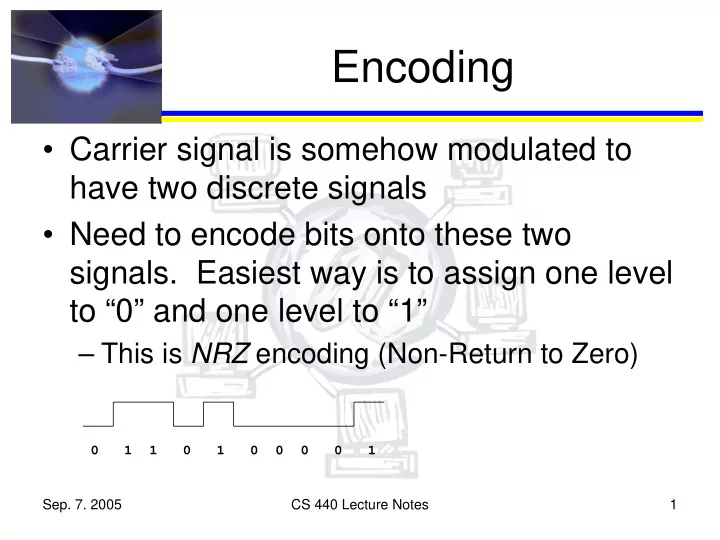

Encoding • Carrier signal is somehow modulated to have two discrete signals • Need to encode bits onto these two signals. Easiest way is to assign one level to “0” and one level to “1” – This is NRZ encoding (Non-Return to Zero) 0 1 1 0 1 0 0 0 0 1 Sep. 7. 2005 CS 440 Lecture Notes 1
NRZ Encoding (cont.) • Problem – too many consecutive bits with the same value causes average signal value to shift in that direction, making it harder for receiver to detect next bit. • Also, lack of transitions make it difficult to recover clock from signal. • One solution is to use NRZI encoding (Non-Return to Zero Inverted) Sep. 7. 2005 CS 440 Lecture Notes 2
Alternative Encodings • Encode 1 as a transition and 0 as no transition – Fixes problem with sequences of 1s, but not 0s • Manchester encoding – XOR clock and NRZ- encoded data – 0 is low-to-high transition, 1 is high-to-low – Transition every bit, so clock recovery easy – Doubles the transition rate, or baud rate , so efficiency is only 50% (bit rate / baud rate). Sep. 7. 2005 CS 440 Lecture Notes 3
4 Encodings CS 440 Lecture Notes Sep. 7. 2005 •
4B/5B Encoding • Similar to NRZI – avoid the inefficiency of Manchester encoding by ensuring bit transitions – Transmit groups of 4 bits using 5 bits – ensures that there is no more than one leading zero and no more than two trailing zeroes – Back-to-back groups cannot cause a run of more than three zeroes – Only 80% efficiency, but better than 50% Sep. 7. 2005 CS 440 Lecture Notes 5
Bit Stuffing • Another alternative is to insert bits only as required to break up long runs. – Use NRZI encoding, and if data contains five zero bits in a row, insert a one bit in the stream. – Receiver will remove all one bits following five zeroes – Bit oriented protocol, since data stream is no longer a fixed number of bits per byte Sep. 7. 2005 CS 440 Lecture Notes 6
Sync vs. Async • Asynchronous – no separate clock signal. – Each side needs to have an approximately correct clock to sample the data – Transmit start bits to sync clock with signal – Need stop bit or bits so you can recognize next start bit • Synchronous – separate line carrying clock signal Sep. 7. 2005 CS 440 Lecture Notes 7
Framing • Group bits of data into message blocks, called frames , for transmission over link • The main problem is finding start and end of each frame. Need to make sure these points can be distinguished from data content of frame. • Different ways to do this – Byte-oriented or character-oriented protocols – Bit-oriented protocols Sep. 7. 2005 CS 440 Lecture Notes 8
Character-Oriented Protocols • Sentinel values – BPS (Burroughs Poll Select), PPP (Point-to- Point Protocol - both async – BSC (Binary Synchronous Communication) – sync • Byte counting – DDCMP (Digital Data Communication Message Protocol) Sep. 7. 2005 CS 440 Lecture Notes 9
Bit-Oriented Protocols • SDLC, HDLC, LAPB (all async) – All very similar, use a special flag sequence (01111110) to delimit frames – Stuff zero bits into data to prevent runs of more than five ones Sep. 7. 2005 CS 440 Lecture Notes 10
Recommend
More recommend